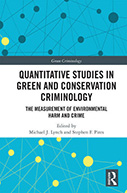Quantitative Studies in Green and Conservation Criminology

Authors: Michael J. Lynch & Stephen F. Pires
Publisher: Routledge, 2019. 236 pages.
Reviewer: Angus Nurse ǀ June 2022
Quantitative Studies in Green and Conservation Criminology is published as part of Routledge’s Green Criminology book series, edited by Michael J Lynch and Paul B. Stretesky. This book, edited by Michael J. Lynch and Stephen F. Pires, features contributions based on empirical quantitative studies of green and conservation crime and justice issues. The various chapters within this volume provide contributions from both well-established scholars such as Lynch and Stretesky, together with works by less established scholars who nevertheless make a contribution to green criminological thought. The book contains a collection of thought-provoking pieces which seek to broaden the focus and scope of green criminology. In their introduction, Lynch and Pires identify that while the vast majority of criminological research (approximately 90%) is empirical ‘within the green criminological literature, at most 10% of the published research is empirical’ (2019: 3). Yet Lynch and Pires identify that when looking at what actually gets published in criminology journals, the evidence suggests that empirical/quantitative studies dominate. Thus, when Buckler (2008) assessed the contents of five upper-tier and three lower-tier criminology journals from 2003 to 2007, he reported ‘that 90.7% of published studies in those journals used quantitative data and empirical methods’ (Lynch and Pires 2019: 10). Lynch et al, (2017) also estimated that only about 10% of green criminology studies are empirical/quantitative, and thus a conclusion could be drawn that green criminological research may struggle to gain acceptance within the main criminology and criminal justice journals.
Spread over 11 substantive chapters plus its introduction, Quantitative Studies in Green and Conservation Criminology explores both the nature of quantitative studies within the green criminological literature as well as showcasing specific quantitative studies in areas such as: investigating crimes impacting primates; urban bushmeat trafficking; human-wildlife competition; trends in hazardous waste violations, and a comparison of illegal wildlife seizures between the US and the EU. Thus, the book’s strength is in providing a useful overview of quantitative study in green and conservation criminology, and it provides an assessment of the ‘health’ of quantitative study in the field, as well as providing some direct examples of quantitative and empirical studies based on specific aspects of green crime.
The book’s strength is in bringing together potentially disparate studies in green and conservation crimes into a coherent discussion of how quantitative and empirical studies can enhance our understanding of green crimes. In assessing the scale of green criminological study, Thomson, et. al. conduct a quantitative bibliometric network analysis of 118 green criminology peer-reviewed studies published between 2000 and 2017. They show that ‘the subdiscipline [of green criminology] is rooted in the common “trunk” of green criminology which then splits into three broad “branches” which include: (1) conservation criminology, (2) environmental justice/victimology, and (3) eco-global/cultural green criminology’ (2019: 26). Their analysis shows that published green criminological papers have begun to appear in five key journals: Critical Criminology, British Journal of Criminology, Crime, Law and Social Change, Theoretical Criminology and Social Justice Research. However, they echo Lynch and Pires’ conclusion that green criminological work ‘remains absent from the discipline’s top-tier journals,’ and thus there is still some work to be done for green criminology to be fully accepted within the criminological mainstream.
Following on from the Thomson, et. al. analysis, chapter 3 of the book ‘takes stock’ of quantitative studies in green and conservation criminology. Via analysis of 117 quantitative studies published between 1998 and 2018, the chapter shows that the quantitative green criminological research falls into five broad areas: (1) environmental justice; (2) the distribution and consequences of pollution; (3) the social control of environmental crime; (4) environmental social movement research; and (5) harms against nonhuman animals. While the chapter flags the nature and diversity of this quantitative research, however, it also notes a reluctance of mainstream criminology to reference this work or engage with issues of environmental harm and animal crime in any meaningful way.
While the book is not organized thematically, several chapters present studies related to wildlife crime and crimes against animals. This reflects the prevalence of these types of studies within green criminology, and the potential for wildlife related studies to attract funding given the political attention afforded to threats against wildlife. Lauren Wilson and Justin Kurland set an agenda for criminological investigation of crimes impacting primates. Their study, situated within conservation criminology and crime science, analyzed the purpose of primate hunting and identified determinants of high extinction risk for primates. Using data on species threats, they evaluated the relative impact on global primate populations of eight threats: (1) habitat loss, (2) habitat fragmentation, (3) use for food, (4) use as pets, (5) various cultural uses, (6) sport hunting, (7) biomedical research, and (8) human-wildlife conflict. Their analysis concludes that future criminological investigation should be directed primarily towards ‘illegal land clearing or disturbance in primate habitat, the poaching of primates for meat and pets, and the illegal trade of primate meat and live primates’ (2019: 80). Interestingly the analysis identified that four threats (cultural uses, human-wildlife conflict, sport hunting, and medical research) were relatively insignificant as threats to primates. Blount-Hill and Natarajan explore human-wildlife competition in a related chapter which examines the relationship between measures of direct human activities, ecological/environmental conditions affected by those activities and the number of species under existential threat across individual countries. Their conclusion that human activity is associated with species loss is one that is regularly expressed by NGOs and known to green criminologists already operating in the areas of wildlife crime. Van Uhm, Pires, Sosnowski and Petrossian conduct a comparison of illegal wildlife seizures between the US and EU, noting that seizure data provide valuable information about import and export countries and seizure analysis is an accepted methodology for assessing wildlife trade practices. They assessed seizure data between 2003 and 2010 analyzing over 28,000 seizures from the US LEMIS database and over 15,000 from the EU-TWIX database. They found that over half of the species illegally imported in both markets were reptiles and mammals, and that reptile products and raw mammal products dominated seizures within these groups. Reptiles alone (including snakes) were the largest group in both markets, making up approximately one third of seizures. Imports for the unregulated leather industry have previously been identified as an issue in the large number of reptiles illegally imported and killed annually. Trade in mammal products, primarily for traditional Asian medicine, was also identified as an issue in both markets. As green criminologists have noted in various publications, illegal markets thrive wherever there is demand for products, and this is especially so with respect to the trade in wildlife and products derived from wildlife (Wyatt, 0213). The study by Van Uhm, et. al. showed some important dimensions of the exploitation of wildlife, and illuminated the numbers of wildlife and derivatives entering into different markets.
Two studies in this volume deal with problems of waste — a substantive area of study in green criminology but also of interest to mainstream criminology given the links with organized crime. Lynch examined a ten-year (1999-2008) trend in hazardous waste violations and punishments in the US. Using data from the US Environmental Protection Agency’s Resource Conservation and Recovery Information System (RCRIS), he looked at the distribution of pollution, pollution violations, and punishments for environmental offences. He found that most Resource Conservation and Recovery Act (RCRA) violations are administrative or regulatory violations, rather than being crimes from a traditional criminological definition of crime; and few are treated as criminal violations by environmental regulators. He found that there were 9,719 violations (an average of 194.4. violations per state) over the ten years studied. Ninety-five percent of these violations met with some type of enforcement activity, while only 16% of cases drew a financial penalty. Lynch concluded that the low frequency of violations indicates that either hazardous waste violation is rare, or that enforcement is limited. Where fines were handed out, these tended to be small.
Continuing with the study of waste crimes, in Chapter 10, Andreatta examines the geographical distribution of waste crimes in Italy. The problem of legal and illegal waste management is an accepted criminological concern, and includes both appreciation that illegal and improper waste disposal can cause pollution and human health hazards, and is linked to wider concerns about the availability and provision of illegal services (particularly by organized crime groups), which can also impact negatively on legitimate waste management services and the proper disposal of waste. The chapter’s analysis found roughly 5,550 waste crimes per year in Italy across its 110 provinces. The majority of these waste crimes occurred in southern Italy.
Green criminology encompasses a range of green perspectives which, among other things, provides a mechanism for rethinking the study of criminal laws, ethics, crime and criminal behaviour, and regulatory approaches to environmental problems. But as Lynch and Pires show, in order to break into the mainstream of criminological discourse, green criminology needs to engage with empirical data and quantitative study alongside its theorising and policy/enforcement analysis. Quantitative Studies in Green and Conservation Criminology is an important entry into the green criminological literature that provides for timely discussion of the ways in which measurement of environmental harm and crime can add to development of the field, and the type of analysis valued by mainstream criminology. Across its 12 chapters, Quantitative Studies maps various aspects of empirical data-driven green criminological study identifying both the important aspects of crime measurement that illustrate the extent and nature of environmental and wildlife threats, but crucially also considering where green criminology’s use of quantitative method can aid in the understanding of environmental harms, and can inform policy and enforcement approaches to dealing with such harms. The range of topics in the book is perhaps slightly limited towards topics such as wildlife and species threats and waste crimes, and the omission of studies relating to air pollution and climate change cases is notable. But this is perhaps inevitable given the importance attached to wildlife and waste crimes as major green crime issues — likely to attract the attention of funders and researchers and suitable for the types of quantitative study included within the book’s analysis. Overall, the book provides a useful analysis of the state of quantitative green criminological thought, and contains a range of interesting studies useful to scholars across the green criminological spectrum as well as mainstream quantitative criminology scholars.
References
Buckler, K. (2008) ‘The qualitative/qualitative divide revisited: A study of published research, doctoral program curricula, and journal editor perceptions’ Journal of Criminal Justice Education, 19 (3): 383-403.
Lynch, M.J., Long, M.A., Stretesky, P.B. and Barett, K.A. (2017) Green criminology: Crime, justice and the environment, Berkeley: University of California Press.
Lynch, M.J., and Pires, S.F. (2019) ‘Introduction to quantitative and empirical studies in green and conservation criminology’ in Michael J. Lynch and Stephen F. Pires. (eds) Quantitative Studies in Green and Conservation Criminology, Abingdon: Routledge.
Wyatt, T. (2013) Wildlife Trafficking, Basingstoke: Palgrave Macmillan.
Angus Nurse, Nottingham Trent University


